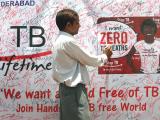New tuberculosis (TB) cases and deaths from the disease continued their long-term decline in 2012, but about a third of cases went undetected, and the response to multidrug-resistant TB (MDR-TB) remains far from adequate, the World Health Organization (WHO) said today in its annual report on the disease.
An estimated 8.6 million people contracted TB last year, and 1.3 million died, the agency said. The estimates for 2011 were 8.7 million new cases and 1.4 million deaths.
The agency estimated that roughly 3 million TB cases, or 1 out of 3, were not picked up by health systems in 2012. Twelve countries are believed to account for 75% of the missed cases
The WHO also said only 94,000 of an estimated 450,000 MDR-TB cases were detected, signaling that progress toward diagnosis and treatment goals is "far off-track." And of the MDR-TB cases that were diagnosed, 16,000 went untreated because of inadequate resources.
"Quality TB care for millions worldwide has driven down TB deaths," Mario Raviglione, MD, director of the WHO Global TB Programme, said in a WHO press release. "But far too many people are still missing out on such care and are suffering as a result. They are not diagnosed, or not treated, or information on the quality of care they receive is unknown."
He called the inadequate response to MDR-TB "a real public health crisis."
On the positive side, the latest data confirm that the world is on track to meet the 2015 Millennium Development Goals of reversing TB incidence and reducing the TB mortality rate by 50%, according to the report.
More specifically, the rate of new TB cases has been falling in all six WHO regions for about a decade. The rate of decline is about 2%, which the agency termed slow. The mortality rate has dropped 45% since 1990, indicating that a 50% reduction by 2015 is within reach.
Two WHO regions, the Americas and the Western Pacific, have already achieved the 2015 targets for reduced incidence, prevalence, and mortality, the report says.
Also, of 22 "high TB burden" countries that account for about 80% of global cases, seven have met all the 2015 targets for reductions in TB incidence, prevalence, and mortality. Four more countries are on track to do the same.
On the other hand, the overall prevalence of active TB in the community is down 37% since 1990, which means that the target of a 50% reduction by 2015 is not likely to be achieved, the report states.
The African and European regions are not likely to meet the mortality and prevalence goals. Of the 22 high-burden countries, 11 are not on schedule to meet the targets for incidence, prevalence, and mortality.
Another challenge is the co-epidemic of TB and HIV, according to the WHO. Although many countries have made progress in addressing it, less than 60% of co-infected patients were receiving antiretroviral therapy in 2012. "Global-level targets for HIV testing among TB patients and provision of antiretroviral therapy to those who are HIV-positive have not been reached," the report states.
It says that an estimated 1.1 million of the 8.6 million people who contracted TB in 2012 were HIV-positive, about 75% of them in Africa.
The report recommends five priority actions that could improve progress between now and 2015:
- Reach the 3 million missed cases by expanding access to quality testing and care services
- Urgently address the MDR-TB problem
- Build on TB-HIV successes to get as close as possible to full antiretroviral treatment coverage for co-infected people
- Increase domestic and international funding to close the resource gap—now estimated at $2 billion per year—for an effective TB response in low- and middle-income countries
- Accelerate the uptake of new tools through technology transfer and operational research
See also:
Oct 23 WHO press release
WHO TB report landing page
Oct 28, 2012, CIDRAP News story on last year's TB report






















